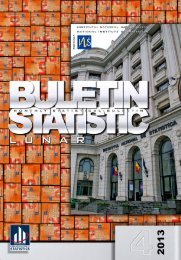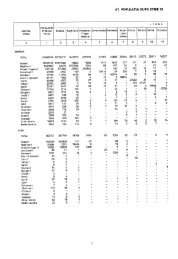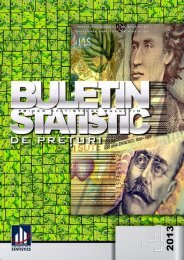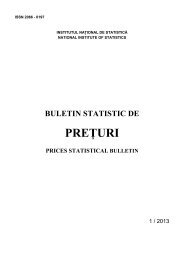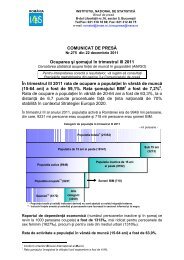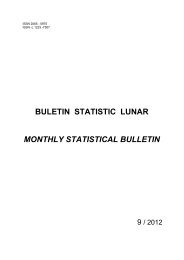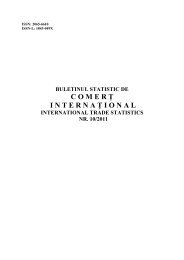BULETIN STATISTIC LUNAR MONTHLY STATISTICAL BULLETIN
BULETIN STATISTIC LUNAR MONTHLY STATISTICAL BULLETIN
BULETIN STATISTIC LUNAR MONTHLY STATISTICAL BULLETIN
Create successful ePaper yourself
Turn your PDF publications into a flip-book with our unique Google optimized e-Paper software.
Estimările în preţurile medii ale anului 2000 secalculează prin înlănţuirea indicilor de volum.Datele sunt prezentate conform CAEN Rev.2.Pe lângă estimările brute ale Produsului internbrut trimestrial, începând cu anul 2009 secalculează şi estimări ajustate sezonier prinmetoda regresivă, metodă recomandată deregulamentele europene.Ajustarea sezonieră are drept scop eliminareaefectelor sezoniere din cadrul seriei de datepentru a se evidenţia evoluţia economică realădin perioade consecutive.Pentru ajustarea seriilor principalelor agregatepe baza cărora se estimează PIB prin metodade producţie şi metoda cheltuielilor, se utilizeazăpachetul de programe DEMETRA (metodaTRAMO/SEATS). Acesta realizează estimareaefectului sezonier (evenimente care se întâmplăîn acelaşi moment, cu aceeaşi magnitudine şidirecţie în fiecare an, cum ar fi: anotimpuri,vacanţe etc.), a numărului de zile lucrătoarediferit de la o lună la alta şi efectului calendarului(Paştele ortodox, an bisect şi alte sărbătorinaţionale) precum şi identificarea şi corectareavalorilor extreme (schimbări de nivel ocazionale,tranzitorii sau permanente) şi interpolareavalorilor lipsă.Conturile naţionale trimestriale din Româniaprezintă, în general, o puternică sezonalitate,efectul zilelor lucrătoare şi al calendarului fiindnesemnificativ. Din acest considerent nu estenecesară aplicarea de metode de ajustare pentruaceste două componente.Seria ajustată sezonier s-a obţinut prineliminarea din seria brută a acestui efect, cuajutorul unor coeficienţi de corecţie, stabiliţi înfuncţie de modelul de regresie folosit (aditiv saumultiplicativ). Modelul aditiv sau multiplicativfolosit pentru regresie este identificat automat deprogramul DEMETRA în funcţie de natura seriilorsupuse ajustării.PIB-ul ajustat sezonier se obţine prin metodadirectă, ceea ce conduce la apariţia uneidiscrepanţe statistice între PIB şi sumacomponentelor sale ajustate sezonier în modindependent.Stabilirea modelelor de regresie folosite pentrufiecare serie se face la începutul fiecărui an şiimplică recalcularea seriilor ajustate calculate înanul precedent (recalculare datorată modificăriimodelelor adoptate numărului de regresorifolosiţi şi numărului de observaţii disponibile).year 2000. The estimates in average prices of2000 are calculated by chain-linking volumeindices.The data are presentend according to CANERev.2.Besides the gross estimates of Quarterly GrossDomestic Product, seasonally adjusted estimatesis also compiled beginning with 2009, based onthe regressive method, this method beingrecommended by the European regulations.The seasonal adjustment envisages the removalof seasonal effects from the data series in viewto highlight the real economic evolution duringconsecutive periods.In order to adjust the main aggregates series,based on which the GDP is estimated throughthe production and expenditure methods,DEMETRA software package is used(TRAMO/SEATS method). This leads to theestimation of seasonal effect (events takingplace each year at the same time, with the sameamplitude and orientation, such as: seasons,holidays etc.), of the working days numberdifferent from one month to another and thecalendar effect (orthodox Easter, leap year andother national holidays) as well as to the outliersidentification and correction (circumstantial,transitional or permanent changes in level) andto missing data interpolation.The quarterly national accounts of Romaniagenerally show a strong seasonality, while theeffect of working days and of the calendar beingnot significant. For this reason no adjustmentmethod is necessary for these two components.The seasonally adjusted series was obtained byremoving this effect from the unadjusted series,by means of correction coefficients, selecteddepending on the regression model used(additive or multiplicative). The additive ormultiplicative model used for regression isautomatically identified by the DEMETRAsoftware, depending on the nature of series thatare subject to adjustments.The seasonally adjusted GDP is obtainedthrough the direct method, thus leading to astatistical discrepancy between the GDP and thesum of its components, which are independentlyseasonally adjusted.The selection of regression models used foreach series takes place at the beginning of eachyear and entails a revision of adjusted seriescompiled during the previous year (revision dueto the changes of selected models, of regressionfactors number and of available observations216



